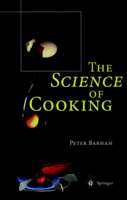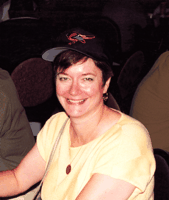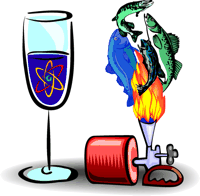Culinary Chemistry

If you have ever wondered exactly why some meat is red and some is white, or why fish has so much lighter a texture than beef, or how mystery meat becomes that way, or how many atoms are in a glass of wine, or if it is possible to cook fish with a blowtorch, The Science of Cooking is the book for you. Even if none of these questions have kept you awake at night, this book is a fascinating exploration of the chemical reasons and reactions behind how and why food is cooked the way it is. Peter Barham has long been involved in popularizing science in Great Britain, and he has combined his knowledge of physics and chemistry with his obvious love of cooking into this book.
The Science of Cooking is a unique combination of scientific explanation, tasty-sounding recipes, and don’t-try-these-without-adult-supervision experiments. The first several chapters cover some rudimentary concepts of the chemistry and physics involved in cooking, including discussions of simple and complex sugars, foams and bubbles, heat transfer, and protein denaturation. Barham explains that large molecules such as proteins and starches have virtually no flavor or odor and that they only develop taste and aroma when they undergo chemical reactions to produce small molecules. He spends a significant amount of time describing the Maillard reaction between amino acids and sugars (resulting in browning), and the optimum conditions under which it occurs. The Maillard reaction recurs throughout the book as Barham describes how to cook the most flavorful meats, sauces, and stocks.
Following a description of various types of cooking utensils, the author moves into the main part of the book, dealing with meat and poultry, fish, breads, sauces, sponge cakes, pastry, soufflés, and my own personal favorite, chocolate. Each chapter addresses the topic by discussing the chemistry, biology, and physics behind cooking the given type of food. Several illustrative recipes are given, followed by a table that outlines possible failures, the scientific reasons for failures, how to salvage a recipe gone wrong, and how to prevent such failures from happening. Finally, each chapter ends with some simple, usually inedible, experiments to try to illustrate the principles described earlier in the chapter. These range from the daring (how to make a light bulb light up in the microwave oven without exploding) to the mundane (how to collapse soap suds by adding oil).
In his chapter on “Meat and Poultry,” Barham explains how heating meat causes the muscle proteins to denature and contract and thereby harden the meat. The more the meat is cooked, the more the muscle proteins denature into this contracted state, and the tougher the meat becomes. He explains how myoglobin and the different types of myosin are responsible for dark meat in heavily used muscle tissues. Similarly, in the fish chapter, he explains why the aqueous environment in which fish live and their buoyancy results in their having a very different arrangement of muscle proteins from mammals, with much less tough connective tissue necessary to connect the muscles to bones. These chapters contain delicious sounding recipes for boeuf bourguignon and fish and chips. It is in the fish chapter where you will learn how to cook fish with a blowtorch and how and why that works.
The chapter on breads describes how gluten is formed, which kinds of breads require it and which don’t, and why kneading is critical for some recipes and suicidal for others. You can also learn about the differences in types of flour (mostly based on the amount of protein) and in types of yeast and why bread gets stale—the starch granules recrystallize into a new shape after baking, which tends to absorb the free water from the bread—and how to reduce staling (add fat).
The chapter on sauces not only addresses the different thickening agents used and why they work, but also provides tips for creating the most flavorful stocks (hint: it involves the Maillard reaction). Also described are how to make salad dressings, mayonnaise, and a perfect, non-separating cheese fondue.
I have always thought that cake baking was more of an art than a science, but the author has almost succeeded in convincing me otherwise. He goes through a simple cake recipe and describes why each step is necessary. The flour and fat have to be mixed together to make very fine crumbs to coat the starch granules with fat, which prevents the protein in the flour starch granules from absorbing water and sticking together. The batter needs to be beaten to stretch the gluten and add elasticity, which allows the batter to hold the air bubbles as they expand during the baking process. The eggs should be beaten to a very light color because this means that the air bubbles incorporated during beating are becoming smaller and smaller, and the smaller they are, the better the cake will rise. Fat should be added only at the very last minute because it will cause the bubbles to coalesce and the cake to rise less. The cake should be dropped from a height of twelve inches upon removal from the oven (yes, dropped) to redistribute the air pockets in the cake so that it doesn’t collapse when the air bubbles deflate at different rates. All concepts are illustrated with recipes such as black forest gateau, too rich chocolate cake, and basic genoise.
Similarly, Barham provides the basis for puff pastry, as well as a clever experiment using colored modeling clay to demonstrate how the fat gets distributed between the pastry layers. Recipes are included for choux pastry, puff pastry, flan pastry, and raised pastry. Most of the recipes in this chapter are uniquely British—steak and kidney pie, sausage rolls, and strawberry slice. In his chapter on soufflés, he again goes into the importance of air bubbles in the rising process and the devastating effect that too much fat can have on this process. By following his recipe for an essentially fat-free soufflé, the author guarantees, it is possible to make a soufflé that will not only rise perfectly, but will also withstand having the oven door opened and slammed shut halfway through the cooking process.
The final chapter is a departure from the rest of the book in that it really describes more of the history and production of chocolate, rather than its use in cooking. There is, however, an exotic and somewhat complicated recipe for Mexican mole.
Perhaps most important for anyone wanting to fully savor this book by trying its recipes are the appendices. Since the author is British, all weights and measures are metric. The appendices handily convert all of these to US equivalents, as well as converting weight equivalents (the British preference) to volume equivalents (the American preference) for many common foodstuffs.
All in all, I enjoyed this book far more than I expected to and am looking forward to getting it back from the Editor so that I can actually try some of the recipes in it.
Dr. Peter Barham is a Reader in Physics at Bristol University and a columnist for The Guardian. In 1999, he received the Institute of Physics Prize for Promoting the Public Awareness of Physics.

- © American Society for Pharmacology and Experimental Theraputics 2002




